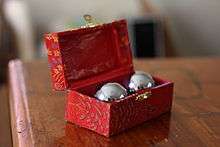Baoding balls

Baoding balls (Chinese: 保定健身球; pinyin: Bǎodìng Jiànshēn Qiú) are metal balls small enough to hold in one hand. They are also known as Chinese exercise balls, Chinese health balls, Chinese meditation balls, Chinese medicine balls. Baoding balls are used by rotating two or more balls repeatedly in the hand. Intended to improve finger dexterity, relax the hand, or aid in the recovery of muscle strength and motor skills after surgery, Baoding balls work similarly to Western stress balls.
History
The first Baoding balls were likely created in Hebei, China, during the Ming Dynasty. Formerly, they were often called "iron balls" as they were originally made of iron. Meditation balls continue to be produced there.[1]
Composition
As metalworking advanced, "iron balls" became more popular. Construction methods varied. Most Baoding balls consist of a pair of hollow spheres, each containing a chime that rings when an inner ball strikes the outer sphere. Many modern examples are decorated with cloisonné and brass wire; these are essentially decorative since they easily chip when dropped or rubbed together. Baoding balls can also be made of solid jade, agate, marble, and other types of stone.
Hollow balls are generally more suitable for therapeutic use due to their lighter weight. Heavier balls of iron, steel or tungsten carbide require more effort for rotation. These are mainly used to build strength by resistance training.
Use
The basic exercise consists of holding a pair of Baoding balls in the palm of one hand, rotating them (switching the relative position of the two balls) while maintaining constant contact between them.
Once this technique has been mastered, the rotation speed can be gradually increased until the balls separate in the hand. Eventually one hand can learn to rotate them completely without the balls making contact with each other. Exercises have been developed involving more balls, where the main technique is to avoid contact with the other balls. This requires using a finger, usually the index finger, as a divider.
An average user should be able to start with a 45mm (1.8in) ball and move up to 60mm (2.4in) as their muscles get accustomed to the exercise. Larger Baoding balls between 70mm and 100mm (2.8in to 3.9in) can be used. Keeping larger balls separate while rotating them is an advanced skill.
The area of the hand exercised can be varied, altering the part of the hand they rotate over, or changing the orbit of the balls so that more force is exerted on a particular finger or finger joints.
Well-known strongmen such as John Brookfield used shot put balls as Baoding balls, rotating them to develop forearm muscles and improve their grip.
Health benefits
Though unsupported by scientific evidence, baoding balls are thought to exercise hand muscles, improve brain function and reduce stress when used as alternative medicine to stimulate the acupuncture points on the hand.[2]
In popular culture
- In the Japanese television series Kamen Rider Fourze, the character Kou Katsuragi (also known as Leo Horoscopes) used a pair of walnuts as Baoding balls, creating a distinctive grinding, rattling sound.
- The Chinese film Fearless featured a scene where Master Chin (Chen Zhi Hui) used them.
- Dr. Blake used Baoding balls in the movie Veronika Decides to Die (2009).
- In Open Season 3 (2010), Fifi is seen using Baoding balls several times.
- The children's television series Strange Days at Blake Holsey High featured a Baoding ball originally owned by the protagonist, Josie Trent. She lost one during a trip to the past, where it wound up gaining unusual properties and became a plot device.
- Arnold Rimmer, a character from the television show Red Dwarf, used Baoding balls in the episode Rimmerworld. The balls were prescribed to him as treatment for a stress-related condition. In this episode, Rimmer is imprisoned for 557 years, during which time he manages to wear the balls down to the size of peas.
- In Orphan Black, the character Rudy played with a pair of Baoding balls.
- In Boyz n the Hood, the character Jason "Furious" Styles (played by Laurence Fishburne) used a set of Baoding balls while working in his home.
- In Labyrinth (1986), Jareth is occasionally seen rotating two of his crystal balls in his hand, much in the same way as one rotates a set of Baoding balls.
- In The Pacific, a mortally wounded woman is discovered by Eugene Sledge when she is brought to his attention by the jingling of her Baoding balls.
- In X-Men: Days of Future Past, Erik / Magneto uses a set of metal Baoding balls to infiltrate the CIA, using the balls to knock out the three security personnel guarding his helmet.
- In The Caine Mutiny, 1954, Captain Queeg, played by Humphrey Bogart, is shown rolling a pair of Baoding balls in his right hand during stressful situations.
Gallery
|
References
| Wikimedia Commons has media related to Baoding Balls. |
- ↑ "History and Types of Baoding Balls". baodingballs.com. Retrieved 26 August 2015.
- ↑ "The Health Benefits of Chinese Baoding Balls". Retrieved 2015-09-23.
